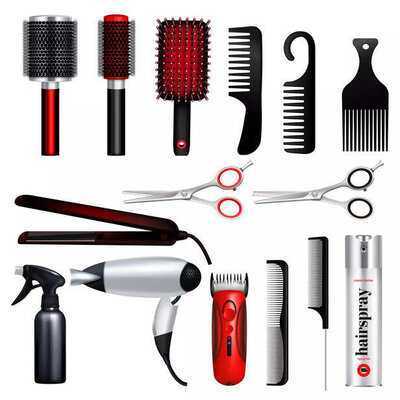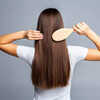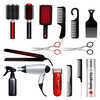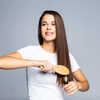
Choosing the right comb seems simple at first glance: pick one and start detangling. Yet the wrong comb can cause breakage, frizz, scalp irritation, uneven styling, and even hair loss. Understanding what comb suits your hair type, texture, and styling goals is essential for healthy hair. This guide explores the eight most critical aspects of comb selection, offering immediate advice and long-term insight so you can stop damaging your hair and start treating it right.
1. Identify Your Hair Type and Texture
 Hair texture varies widely—from thick curls to fine straight strands—and each type demands a specific comb design. Thick, coiled, or curly hair needs wide spacing and sturdy structure to pass through without tugging or breaking strands. Medium, straight hair fares best with medium-spaced teeth that balance detangling and styling. Fine or thin hair benefits from finer teeth that distribute natural oils and smooth the cuticle. Ignoring your hair’s texture and using one comb for all styles risks tangles for curls, breaks for naturals, or limpness for fine hair.
Hair texture varies widely—from thick curls to fine straight strands—and each type demands a specific comb design. Thick, coiled, or curly hair needs wide spacing and sturdy structure to pass through without tugging or breaking strands. Medium, straight hair fares best with medium-spaced teeth that balance detangling and styling. Fine or thin hair benefits from finer teeth that distribute natural oils and smooth the cuticle. Ignoring your hair’s texture and using one comb for all styles risks tangles for curls, breaks for naturals, or limpness for fine hair.
2. Understand Teeth Spacing and Shape
 The spacing and shape of comb teeth determine how hair moves through the tool. Wide-tooth combs prevent pulling and lessen frizz when detangling curls or thick strands. They are also ideal when applied to damp or conditioned hair. Medium-tooth combs—standard salon style—help in everyday brushing, parting, and styling for most hair types. Fine-tooth combs are efficient for smoothing, straightening, and delicate details; they suit fine or thinning hair. Tooth shape matters too: rounded, smooth ends are gentler on the scalp. Flat or sharp-edged teeth can scratch and irritate during brushing.
The spacing and shape of comb teeth determine how hair moves through the tool. Wide-tooth combs prevent pulling and lessen frizz when detangling curls or thick strands. They are also ideal when applied to damp or conditioned hair. Medium-tooth combs—standard salon style—help in everyday brushing, parting, and styling for most hair types. Fine-tooth combs are efficient for smoothing, straightening, and delicate details; they suit fine or thinning hair. Tooth shape matters too: rounded, smooth ends are gentler on the scalp. Flat or sharp-edged teeth can scratch and irritate during brushing.
3. Choose Your Comb Material Wisely Combs are made from plastic, wood, metal, or carbon fiber. Each material brings unique benefits. Plastic combs are budget-friendly but often produce static and accelerate frizz. Wooden combs offer natural smoothness, distribute oils evenly, and reduce static. Their solid frame suits thick and coarse hair. Metal combs are durable, easy to sanitize, and ideal for sectioning hair during styling, but may feel heavy. Carbon-fiber combs resist heat, ideal when used with blow dryers, and offer firm, static-free combing suitable for thick hair. The material you choose affects your end result and the effort needed for maintenance.
4. Match Comb Design to Styling Needs Combs do more than detangle; they support styling. Rouleau tail combs are excellent for parting, teasing, and short detail work like beard grooming. Wide-tooth detangler combs help with soaked, curly, or textured hair, reducing breakage. Vent combs allow airflow and speed up blow-drying, useful for straight or wavy hair. Pocket combs are compact and easy to carry, handy for quick touch-ups. Specialized combs—like afro combs and teasing combs—offer precise assistance. Choose based on your grooming routine: a single comb cannot handle detangling, parting, shaping, and finishing equally.
5. Consider Ergonomic Comfort and Durability Comfort matters in comb selection. Breakage from grip fatigue is common during long grooming routines. Thick handles and lightweight designs help reduce strain. Silicone grip zones prevent slipping, and warm materials like wood feel better to hold. A balanced weight prevents wrist fatigue. Long-lasting combs—constructed with solid materials and strong teeth—avoid snapping or warping. While cheaper combs may save money initially, replacing broken tools quickly becomes more costly and wasteful. Investing in a durable comb with an ergonomic grip is a one-time decision that supports healthy grooming habits.
6. Adopt a Regular Cleaning Routine
 Even the best comb picks up residue from oils, styling products, dust, and dandruff. Dirt and product buildup can roughen the teeth, transfer grime back into hair, and encourage scalp bacteria. Clean combs regularly by soaking in warm water with gentle shampoo, brushing between teeth with an old toothbrush, and drying completely before reuse. Wooden combs require milder cleaners, dri without soaking, and occasional oiling to preserve their finish. Proper maintenance ensures combs stay smooth, hygienic, and effective in detangling.
Even the best comb picks up residue from oils, styling products, dust, and dandruff. Dirt and product buildup can roughen the teeth, transfer grime back into hair, and encourage scalp bacteria. Clean combs regularly by soaking in warm water with gentle shampoo, brushing between teeth with an old toothbrush, and drying completely before reuse. Wooden combs require milder cleaners, dri without soaking, and occasional oiling to preserve their finish. Proper maintenance ensures combs stay smooth, hygienic, and effective in detangling.
7. Use Proper Brushing Technique
 Choosing the right comb is only the first step. The way you use it matters just as much. Begin from the ends and work upward, easing out tangles gradually, rather than pulling through full-length knots. For curly or textured hair, descend into individual sections and use a detangling spray if needed. When using a comb for styling or dividing, use clean, dry hair and a tail comb—sharp strokes help define lines. Avoid combing wet hair with fine-tooth combs, which overstretches fragile strands. Holding the hair close to the root reduces pull. Gentle, mindful handling takes as much care as the comb’s design.
Choosing the right comb is only the first step. The way you use it matters just as much. Begin from the ends and work upward, easing out tangles gradually, rather than pulling through full-length knots. For curly or textured hair, descend into individual sections and use a detangling spray if needed. When using a comb for styling or dividing, use clean, dry hair and a tail comb—sharp strokes help define lines. Avoid combing wet hair with fine-tooth combs, which overstretches fragile strands. Holding the hair close to the root reduces pull. Gentle, mindful handling takes as much care as the comb’s design.
8. Replace Worn or Damaged Combs Promptly Combs don’t last forever. Signs of wear include bent or broken teeth, missing patches of teeth, rough or chipped edges, and teeth misaligned. Damaged combs snag hair, cause breakage, and scratch the scalp. Replace them as soon as these signs appear. A quality comb lasts several years if cared for, but a broken one can reverse your healthy hair habits. Regularly inspect comb teeth for damage and make replacement a habit—your hair will thank you.
Conclusion Choosing the right comb can transform your hair routine from damaging to nurturing. When you align comb choice with hair texture, styling needs, material preference, ergonomic design, hygiene habits, and usage technique, you build stronger, shinier, and healthier hair. Investing three minutes to assess your hair type, picking a comb that fits your daily habits, and cleaning it properly forms the foundation of smart grooming.
Stop guessing about comb styles and speeds and give your hair the tool it deserves. The right comb supports your beauty goals while preventing damage and frustration. With this guide, you can take confident steps toward better hair days, woven through mindful picking, proper use, and thoughtful care. Your next brush won't just detangle—it will support healthy hair growth, shine, and strength.
Explore the latest trends and tips in Health & Fitness, Travel, Life Hacks, Fashion & Beauty, and Relationships at Times Life!
Frequently Asked Questions (FAQ's)
Yes—using the wrong comb can lead to breakage, frizz, and scalp irritation.
A wide-tooth comb is ideal for detangling thick or curly hair without causing damage.
Wooden combs are gentler on the scalp and help reduce static and hair fall.
-
How this former India cricketer became friends with Pele

-
How this former India cricketer became friends with Pele

-
Madhya Pradesh: 74K Revenue Cases Resolved In Jabalpur Division In May

-
Liverpool line up next summer transfer after Arne Slot's £180m splurge

-
Canada promises response to increased US tariffs if no trade deal is reached
